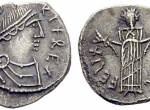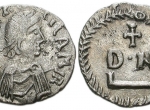Vandals
Vandals (in the written record: Vandali or Vandili) – ancient →Germanic tribe, originally residing on the territory of today’s Poland, identified with the archaeological →Przeworsk Culture communities. Information given by classical authors about the origins and the more distant past of V. is very modest and focuses on their later history, mainly after the arrival of this people in Africa. The earliest references concerning 1st century AD, are in Pliny the Elder (Naturalis Historia, IV, 99) and Tacitus (Germania, § 2). They suggest that even in those days the V. were a major tribe, possibly, a federation of tribes, established in western Poland (Greater Poland?), neighbours of the →Goths – the latter unanimously identified by scholars with →Wielbark Culture communities. This would be confirmed by the report in →Jordanes (Getica, 26) about the defeat of the Ulmerugi and V. by the Goths after the arrival of the latter to the southern Baltic coast. In the archaeological material these developments presumably are reflected by the expansion of the Wielbark Culture to northern Greater Poland, possibly also to eastern Mazovia, Podlahia and Lublin Region – formerly settled by →the Przeworsk Culture people. However it is not fully certain whether the inhabitants of south-eastern Poland in fact formed part of the Vandal tribal federation. Paul the Deacon (Historia Longobardorum, I, 7) described the wars between the V. and the →Langobards, ended by the victory of the latter, thanks to the assistance from Godan (Odin) and goddess Freya.
The Vandals are not mentioned by Ptolemy but Tacitus recorded their name in his overview of the Germanic peoples. According to most researchers concerned with the subject, in the 1st century V. most likely formed part of a tribal alliance – the Lugian Federation (Lugiorum nomen), in which they were known under a different name. With time – during the 2nd century AD – they supposedly took over the hegemony in the federation from the Lugii, who until then had been a “great people”. The last reference to the Lugii, in Zosimos, appears in the context of wars of the Roman Emperor Probus. This hypothesis is supported by evidence from archaeology which shows that during the first few centuries AD there was no major change in the territory under Przeworsk Culture settlement, except for the area subjected to expansion of the →Gothic population (→Wielbark Culture). This is true primarily of areas we can identify with the main centres of Lugian settlement found in Lesser Poland, Kuyavia and on the Middle Prosna. It is too early to say at present whether all of these territories, occupied previously by communities of the Lugian federation, later became “Vandal” domains.
References to V. turn up in accounts of the Marcomannic Wars (AD 166-180). Eutropius and Orosius when they name the enemies of Rome place Vandals in third place, after the Marcomanni and the Quadi. But is not clear whether this image is not a projection of the later perception of Vandals, who at the end of Antiquity were perceived by the Romans as havoc wreaking heretics – for at the end of the 4th century the Vandals, like the →Goths and →the Gepids, embraced →Arianism. In written sources on the 3rd century there are references to conflicts but also to alliances between Romans and V. During the Marcomannic Wars one of the Vandal tribes – the Hasdingi (Asdingi) – made wars on the Dacians. Researchers agree that in the archaeological record this is reflected by the spread of →Przeworsk Culture settlement to the Upper Tisa region.
On New Year’s eve of 406/407, some 100-150.000 Vandals, around 20.000 commanded by Godigisel, crossed the Rhine into Gaul and laid it waste for almost three years. During the same time (end of phase D1) there is evidence in the archaeological record on the collapse of the previously stable settlement network of the →Przeworsk Culture. In the autumn of 409 the Vandals moved into Spain and settled there for a time. Their “Spanish” episode abounded in conflicts with Romans, and with other Germanic tribes (Alamanni, Suebi and →Visigoths), the result being a substantial weakening of one of their tribes – the Silingi. A memento of V. presence in that region is the name of the southern Spanish region of Andalusia.
In 429, led by their king Gaiseric, the V. are seen on the move again, crossing the Strait of Gibraltar and taking control of western North Africa. They established their kingdom there, extending power over towns and the eastern area of the coastal plain formerly, the territory of Carthage and Numidia. Thanks to their powerful fleet in 440-480 the Vandals extended their control over the western Mediterranean Sea region capturing in succession, the Balearic Islands, Corsica, Sardinia and Sicily. The Vandal population of their African kingdom is estimated at around 80.000, most of this number were followers of Arianism. In 455, led by king Gaiseric, V. organised an attack on Rome and brutally sacked the city – hence the word “Vandalism”. The end to the Vandal rule in Africa was brought by Justinian I (527-565), one of the ablest Byzantine emperors. In 533 Justinian’s commander, Belisarius, crossed to Africa at the head of an army of fifteen thousand, captured Carthage and defeated king Gelimer in the decisive Battle of Tricamarum. The Germanic kingdom was captured by Byzantium, Gelimer settled on an estate granted him by the Emperor, his warriors swelled the Byzantine army. In these circumstances the V. soon lost their cultural identity.
A small offshoot of the Vandals had remained in their old homeland; this is confirmed by the narrative of →Procopius of Caesarea: during Gaiseric’s rule in 439-477 an embassy of Vandals from journeyed to Africa from their ancestral abodes to assured themselves that their kinsmen did not intend to return North. An archaeological proof of these “ancestral abodes” could be the vestiges of Germanic settlement from the late →Migration Period in Kuyavia and on the Middle Prosna.
MR
Literature: M. Jahn, Die Wandalen, [in:] H. Reinerth (ed.) Vorgeschichte der deutsche Stämme, vol. 3, Die Ostgermanen und Nordgermanen, Leipzig-Berlin 1940, p. 943-1032; L. Schmidt, Geschichte der Wandalen, Leipzig 1942; H. Łowmiański, Początki Polski. Z dziejów Słowian w I tysiącleciu n.e., vol. I, Warszawa 1963; J. Strzelczyk, Wandalowie i ich afrykańskie państwo, Warszawa 1992; J. Kolendo, Antyczne źródła pisane o najdawniejszych dziejach Wandalów, [in:] Wandalowie. Strażnicy bursztynowego szlaku. Katalog wystawy, Lublin-Warszawa 2004, p. 11-24; J. Strzelczyk, Wandalowie w drodze do Afryki, [in:] Wandalowie. Strażnicy bursztynowego szlaku. Katalog wystawy, Lublin-Warszawa 2004, p. 199-224; M. Mączyńska, Światło z popiołu. Wędrówki ludów w Europie w IV i V w., Warszawa 2013.
-
 full resolution
full resolution
Fig. 1. The coin of Hilderic (523-530).
-
 full resolution
full resolution
Fig. 2. The coin of Gelimer (530-534).


